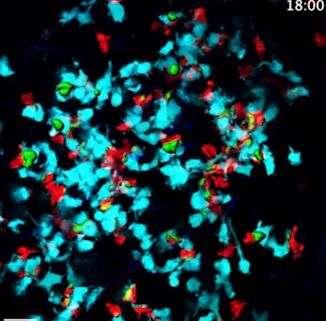Imaging studies open a window on how effective antibodies are formed

Sometimes, in order to understand what's happening in the immune system, you just have to watch it. By imaging the immune response, researchers have observed how two types of immune cells, T and B cells, interact with one another during a critical period following infection in order to prepare the best antibodies and establish long-lasting protection. Their surprising finding: T cells and B cells form numerous short-term contacts, each lasting no more than a few minutes, in a dynamic process that is very different from how T cells interact with other cell types. The results were recently published in Science.
The action takes place in so-called germinal centers, tiny structures within the body's lymphatic system where B cells learn to make antibodies against specific microbes. Within these sites B cells undergo a process known as diversification in which they experience rapid mutations in the genes that encode antibodies. Only the best B cells—those with the highest "affinities"—are selected to leave the germinal centers and become antibody-secreting cells.
"In the germinal centers, T cells discern between B cells that are making effective antibodies and those that are not—it is because of their scrutiny that the immune system learns to take the correct action to fight off infection," says study author Ziv Shulman, a postdoc in Michel C. Nussenzweig's Laboratory of Molecular Immunology. "But nobody had ever observed directly and described the dynamics of this process and little is known about how T cells make their determination."
Nussenzweig, who is Zanvil A. Cohn and Ralph M. Steinman Professor, along with Shulman, and their colleagues, developed a system in which they could observe the germinal centers directly in live mice under physiological conditions, tagging T cells and B cells with separate fluorescent proteins that allowed them to track the movements of the cells in real time. They also developed an algorithm that could process the resulting videos and keep precise track of the quantity of contacts between the two cell types as well as the duration of each contact.
They found that the amount of antigen being picked up by B cells with high affinity antibodies and presented to T cells dictates the duration of interaction between the cells. In these contacts, the B cells are instructed either to differentiate into antibody secreting cells or to undergo further mutation.
To test whether the cells were indeed communicating with one another, the researchers also visualized the amount of free calcium within the cells. They found an increase in intracellular calcium, an indicator of signaling events triggered during the T and B cells interactions. Furthermore, the dynamics of the calcium signaling they observed suggests that not only are T cells telling B cells what to do, but that the flow of information is bi-directional: T cells are also learning from B cells.
"The transient interactional dynamics allow T cells to continuously seek and find B cells that are presenting high levels of antigen and provide them with preferential help, while still permitting competing B cells to mutate and develop," Shulman says. "It's an interactive process, with B cells being directed by T cells and T cells learning from their interactions with B cells."
The research team says that a better understanding of the processes that take place in germinal centers could lead to new ways to manipulate them in order to more effectively harness the body's immune system to develop vaccines and fight a variety of diseases.
More information: "Dynamic signaling by T follicular helper cells during germinal center B cell selection" Ziv Shulman, et al. Science 29 August 2014: Vol. 345 no. 6200 pp. 1058-1062 DOI: 10.1126/science.1257861



















